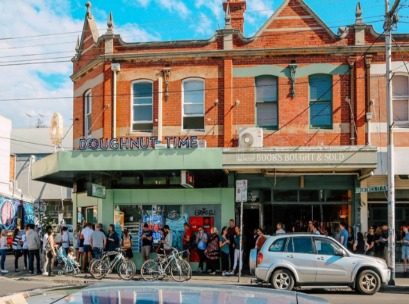 Doughnut Time will be repositioned to capitalise on digital opportunities and will close more stores under the stewardship of its new owner Dan Strachotta.
Doughnut Time will be repositioned to capitalise on digital opportunities and will close more stores under the stewardship of its new owner Dan Strachotta.
Strachotta, who was formerly the chief executive of the business, has agreed to terms to purchase the company from founder Damian Griffiths, after it emerged over the weekend that he was treading water over a series of personal financial problems related to failed business ventures, including KTG Bakeries and the Limes Hotel.
It comes after a group of Doughnut Time staff took Griffiths to Fair Work amid allegations of underpayment last month, as well as a pending lawsuit filed in the Supreme Court by Frasers Property over an alleged breach of contract related to unpaid rent.
Doughnut Time has been closing stores at a rapid rate recently, moving from 30 stores in Australia and the UK to just twelve operational locations.
Inside Retail understands that only seven of these twelve locations will remain open under Strachotta’s new vision for the business.
In a statement Strachotta said that he’ll be taking over the chain’s more promising stores and re-positioning the brand to take advantage of emerging opportunities.
“I will be taking over part of the store network that I believe can recover from a long period of tough trading in a challenging environment for retail,” he said,
“It’s a great brand with a great product, and with a smaller network of shops we can refocus on the simple things that made Doughnut Time a success in the beginning, before it grew too quickly.”
Strachotta said Doughnut time will avoid the “crazy rents” that brought down Griffiths, signalling an intention to work with delivery partners, such as order aggregators, to grow the business moving forward.
“We intend to work with online platforms that can give us growth without the crazy rents that the company previously faced. Online sales and working with delivery partners will be our immediate future strategy, while trying to keep as many of the current employees as possible at the stores,” he said.
Speaking to Broadsheet, Griffiths admitted that he’s “lost the energy to fight” and is “accepting the blame” for the failure, after expanding the business too quickly.
“I am accepting the blame, I expanded too quickly. I guess I had too many big ideas and dreams,” he said.
Griffith’s departure from the business marks the end of a up-and-down journey that at its height saw the brand praised for its popularity with younger shoppers and ability to successfully market itself via social media platforms like Instagram.
Access exclusive analysis, locked news and reports with Inside Retail Weekly. Subscribe today and get our premium print publication delivered to your door every week.





